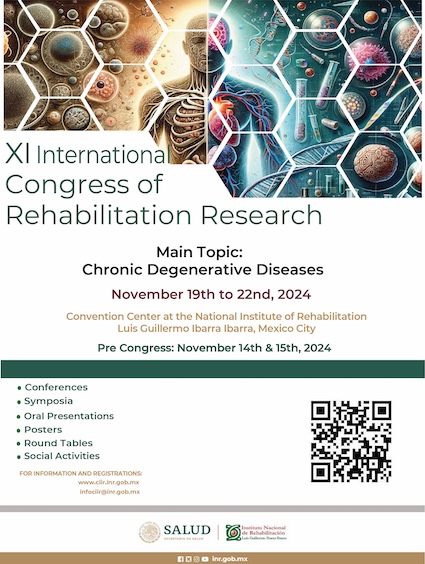Usefulness of psychological techniques for the application of botulinum toxin in pediatric patients with cerebral palsy
Keywords:
Cerebral Palsy, child, botulinum tox ins ty pe A, pain perception, psychological techniquesAbstract
The injection of Botulinum toxin type A (BoNTA) is the main treatment for focal
spasticity in pediatric patients with cerebral palsy (CP). This procedure is often
painful and cause great anxiety in children. There are non-pharmacologic options
that can be used like psychologic techniques (PT) to handle this issue. The pur[1]pose of this study was to describe the results of pain and anxiety assessment in
pediatric patients with CP in two separate applications of BoNTA with and without
the use of PT without sedation. It was descriptive, analytic and quasi-experimental
study designs with an autocontrolled group of pediatric patients with CP were in[1]cluded in the study with a mean age of 7.6 years (± 4.98). Was found a statistically
significant negative correlation between age and pain (rho=-0.951, p<0.001) and
anxiety levels (rho=-0.932, p=0.001). Also there we statistically significant positive
correlation between pain and anxiety levels (rho=0.981, p<0.001). Patients that
completed this evaluation, 80% reported a decrease in pain level, and it was o b[1]served a decrease in anxiety levels in 100% of the patients, both statistically signifi[1]cant (p=0.029 and p=0.004 respectively). We conclude PT may be a useful re[1]source to reduce pain and anxiety levels in pediatric patients with CP during the
injection of BoNTA without sedation.
References
Cans C, Surveillance of Cerebral Palsy in Europe
(SCPE). Surveillance of cerebral palsy in Europe: a
collaboration of cerebral palsy surveys and registers. Dev Med Child Neurol. 2000; 42(12):816-24.
Garreta-Figuera R, Chaler-Vilaseca J, TorrequebradaGiménez A. Guía de práctica clínica para el tratamiento de la espasticidad con toxina botulínica. Rev Neurol. 2010;50(11):685-699.
Pascual-Pascual S, Herrera-Galante S, Póo P et al.
Guía terapéutica de la espasticidad infantil con toxina
botulínica. Rev Neurol. 2007;44(5):303-309.
Mesterman R, Goldie N. Pain induced by Non-sedated
Botulinum toxin injection. What do our patients tell us
about their pain perception and what can be offered to
reduce their pain experience AACPDM, 2014. (acceso
el 3 de diciembre de 2016). Disponible en: https://
www.aacpdm.org/UserFiles/file/BRK20.pdf
Internacional Association for the study of Pain Washington. D.C. IASP Taxonomy. Disponible en: http:
//www.iasppain.org/Taxonomy?navItemNumber=576#
Pain
Míguez-Navarro M. Utilización de un sistema de videodistracción para disminuir la ansiedad y el dolor
en niños durante la venopunción en un servicio de urgencias pediátricas (Internet). Universidad Autónoma
de Madrid, Facultad De Medicina. Departamento de
Pediatría, 2013. (Acceso el 3 de diciembre de 20-
. Disponible en: https://repositorio.uam.es/
bitstream/handle/10486/660231/miguez_navarro_mari
aconcepcion.pdf?sequence=1
Curtis S, Wingert A, Ali S. The Cochrane Library and
procedural pain in children: an overview of reviews.
Evid. Based Child Health. 2012; 7:1363-1399.
Pillai Riddell RR, Racine NM, Gennis HG, Turcotte K,
Uman LS, Horton RE, Ahola Kohut S, Hillgrove Stuart
J, Stevens B, Lisi DM. Non-pharmacological management of infant and young child procedural pain.
Cochrane Database Syst Rev. 2015; 12:CD006275.
Flowers S, Birnie K. Procedural Preparation and Support as a Standard of Care in Pediatric Oncology. Pediatr Blood Cancer. 2015; 62:S694–S723.
Uman LS, Chambers C, McGrat P, Kisely S. A Systematic Review of Randomized Controlled Trials Examining Psychological Interventions for Needlerelated Procedural Pain and Distress in Children and
Adolescents: An Abbreviated Cochrane Review. J
Pediatr Psychol. 2008;33(8):842-854.
Dalley J, McMurtry C. Teddy and I Get a Check-Up:
A Pilot Educational Intervention Teaching Children
Coping Strategies for Managing Procedure-Related
Pain and Fear. Pain Res Manag. 2016; 2016:
Bisogni S, Dini C, Olivini N, Ciofi D, Giusti F, Caprilli
S, Gonzalez Lopez JR, Festini F. Perception of venipuncture pain in children suffering from chronic diseases. BMC Research Notes. 2014; 7:735.
Canbulat N, Inal S, Sönmezer H. Efficacy of Distraction Methods on Procedural Pain and Anxiety by Applying Distraction Cards and Kaleidoscope in Children. Asian Nurs Res. 2014;8(1):23-28.
Cerne D, Sanino L, Petean M. A randomised controlled trial examining the effectiveness of cartoons as
a distraction technique. Nurs Child Young People.
;27(3):28-33.
Duff A, Gaskell S, Jacobs K, Houghton J. Management of distressing procedures in children and young
people: time to adhere to the guidelines. Arch Dis
Child. 2012;97(1):1-4
Uman LS, Birnie KA, Noel M, Parker JA, Chambers
CT, McGrath PJ, Kisely SR. Psychological interventions for needle-related procedural pain and distress
in children and adolescents. Cochrane Database Syst
Rev. 2013; 10:CD005179.
Taddio A, McMurtry C. Psychological interventions
for needle-related procedural pain and distress in chil-
dren and adolescents. Paediatr Child Health. 2015; 20
(4):195-196.
Duff A. Incorporating psychological approaches into
routine paediatric venipuncture. Arch Dis Child. 2003;
(10):931–937.
Engel SJ, Afifi AM, Zins JE. Botulinum toxin injection
pain relief using a topical anesthetic skin refrigerant. J
Plast Reconstr Aesthet Surg. 2010;63(9):1443-1446.
Paracka L, Kollewe K, Wegner F, Dressler D. Strategies to decrease injection site pain in botulinum toxin
therapy. J Neural Transm. 2017;124(10):1213-1216.
Fung S, Phadke CP, Kam A, Ismail F, Boulias C.
Effect of topical anesthetics on needle insertion pain
during botulinum toxin type A injections for limb spasticity. Arch Phys Med Rehabil. 2012;93(9):1643-1647.
Elibol O, Ozkan B, Hekimhan PK, Cağlar Y. Efficacy
of skin cooling and EMLA cream application for pain
relief of periocular botulinum toxin injection. Ophthal
Plast Reconstr Surg. 2007; 23(2):130-133.
Sauceda-García JM, Valenzuela-Antelo JR, Valenzuela-Antelo JR, Maldonado-Durán JM. Estrés ante la
venopunción en niños y adolescentes. Bol Med Hosp
Infant Mex. 2006;63(3):169-177.
Taddio A, McMurtry C et al. Reducing pain during
vaccine injections: clinical practice guideline. CMAJ.
;187(13):975-982.
Harrington JW, Logan S, Harwell C, Gardner J,
Swingle J, McGuire E, et al. Efffective analgesia using
physical interventions for infant immunizations. Pediatrics 2012; 129(5):815-22.
Downloads
Published
How to Cite
Issue
Section
License
Copyright (c) 2018 Instituto Nacional de Rehabilitación Luis Guillermo Ibarra Ibarra

This work is licensed under a Creative Commons Attribution 4.0 International License.
© Instituto Nacional de Rehabilitación Luis Guillermo Ibarra Ibarra under a Creative Commons Attribution 4.0 International (CC BY 4.0) license which allows to reproduce and modify the content if appropiate recognition to the original source is given.



